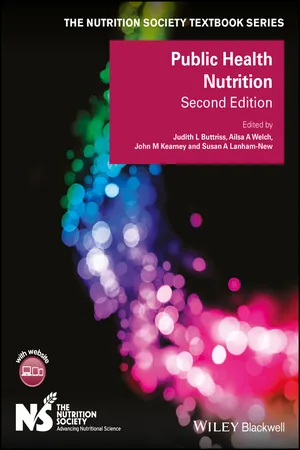
Public Health Nutrition
- English
- ePUB (mobile friendly)
- Available on iOS & Android
About this book
In this second edition of the bestselling title from the acclaimed Nutrition Society Textbook series, Public Health Nutrition has been extensively revised to ensure that it reflects the latest evidence-based knowledge and research. Ground-breaking and comprehensive in both its scope and approach, Public Health Nutrition has been fully updated by an expert editorial team to cover the most recent changes in the field. It now offers a structured overview of the subject's core concepts and considers public health nutrition tools and the application of intervention strategies.
Divided into five key sections, Public Health Nutrition contains a wealth of information, including:
- Public health nutrition concepts and assessment tools, and their application in light of the latest evidence.
- Case studies to illustrate how best to apply the theory and evidence to policy and practice.
- An examination of nutrition throughout the lifecycle, and the relationship between diet and disease, including in relation to obesity, diabetes, cancer, as well as mental health.
- The impact of environmental factors on public health.
- Public health strategies, policies and approaches.
With a clear and concise structure, Public Health Nutrition is an essential purchase for students of nutrition, dietetics and other healthcare areas, as well as an invaluable practical guide for health professionals working within public health.
A supporting companion website featuring multiple-choice, short answer, and essay style questions is available at www.wiley.com/go/buttriss/publichealth
Frequently asked questions
- Essential is ideal for learners and professionals who enjoy exploring a wide range of subjects. Access the Essential Library with 800,000+ trusted titles and best-sellers across business, personal growth, and the humanities. Includes unlimited reading time and Standard Read Aloud voice.
- Complete: Perfect for advanced learners and researchers needing full, unrestricted access. Unlock 1.4M+ books across hundreds of subjects, including academic and specialized titles. The Complete Plan also includes advanced features like Premium Read Aloud and Research Assistant.
Please note we cannot support devices running on iOS 13 and Android 7 or earlier. Learn more about using the app.
Information
Part One
Public Health Nutrition Tools
1
Introduction to Public Health Nutrition
Key Messages
- Nutrition is fundamental for life and health. The term ‘nutrition’ encompasses both biological and sociological aspects of how cells, tissues and organisms access the substrates and cofactors that are necessary for normal conception, growth, development and ageing.
- Public health nutrition refers to nutritional aspects of public health, which is the science and art of promoting and protecting health and well-being, preventing ill health and prolonging life through the organised efforts of society.
- The historical focus of public health nutrition has been on undernutrition, which is still a major problem across all levels of development. In less economically developed countries, it most commonly manifest as deficiencies of micronutrients as well as wasting and stunting (acute and chronic malnutrition) in childhood. In economically developed countries undernutrition is a common feature of ageing, though nutrition-related chronic non-communicable diseases such as obesity, type 2 diabetes, cardiovascular disease and several common cancers predominate. Increasingly, as less economically developed countries undergo nutritional transition, they are experiencing a rising burden of these diseases, so that these are now the major nutrition-related disease burden globally.
- The characterisation of human nutrient requirements is a fundamental activity for public health nutrition, and their application in clinical or public health settings requires training and experience that marks professional nutritional practice.
- Effective public health nutrition requires three discrete functions
- the acquisition, synthesis and dissemination of knowledge relating nutrition to health and disease;
- surveillance programmes to detect potential nutritional problems across the life course among the population, and to monitor change;
- evidence-informed policy development, implementation and evaluation.
- Public health nutrition policy relies on ensuring that people have the necessary information to make healthy choices around food and physical activity, as well as on ensuring that the environment in which they live is conducive to making those healthy choices. Policy makers need to balance the evidence for health need against economic and other socio-political factors in determining what action to take.
1.1 Public Health and Nutrition
1.2 History of Nutrition in Public Health
| WW1 | WW2 | |
| Milk | −26% | +28% |
| Eggs | −40% | −6% |
| Meat | −27% | −21% |
| Vegetables | −9% | +34% |
Table of contents
- Cover
- The Nutrition Society Textbook Series
- Title Page
- Copyright
- Contributors
- Series Foreword
- Preface
- Introduction
- About the Companion Website
- Part One: Public Health Nutrition Tools
- Part Two: Current State of Evidence
- Part Three: Diet and Disease
- Part Four: Environmental Factors
- Part Five: Public Health Nutrition Strategies and Approaches
- Appendix
- Index
- End User License Agreement